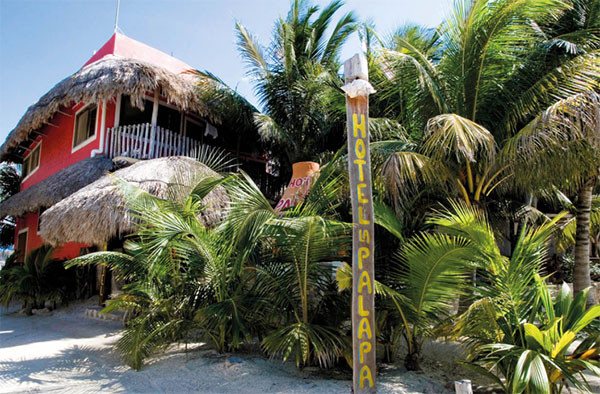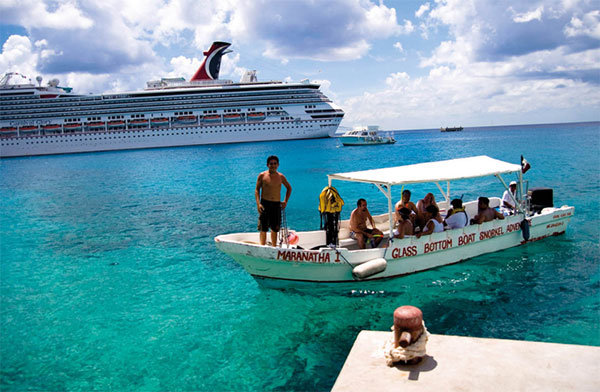Cozumel
South of Isla Mujeres is the much larger island of Cozumel 8 [map] , 47km- (30 miles) long with a lighthouse at each end, and 16km- (10 miles) wide. Cozumel was another island that was a place of pilgrimage for Maya Yucatán in the Postclassic era, with several shrines dedicated to Ixchel. The principal relic of Maya Cozumel is the site of San Gervasio (daily Sept–May 8am–4pm, June–Aug until 5pm), in the middle of the island. Similar in style to Tulum and other post-Classic Maya sites, it is quite widely spread out, so exploring involves an enjoyable walk through the woods, often full of flowers and birds. Among the principal structures is the Chichan Nah complex, probably the residence of the chief lord of Cozumel.
Cozumel was actually discovered for tourism before Cancún even existed, particularly by divers and fishermen drawn by the riches of its reefs. Things remained fairly low-key, however, until Cancún took off: today Cozumel welcomes about 400,000 visitors a year, especially from cruise ships. Frequent passenger ferries run back and forth between the island and Playa del Carmen, and there is a less frequent car ferry service from Puerto Calica, just to the south.

Island style at Hotel Las Palapas on Isla Holbox.
Alex Havret/Apa Publications
There are over 20 reefs along Cozumel’s west coast, providing dives of every degree of difficulty. In many places you can also see a great deal just with a snorkel, or you can observe the underwater wonderland from the comfort of glass-bottomed boats. Nearby are some of Cozumel’s best beaches, such as popular Playa San Francisco, which stretches for 3km (2 miles). Scuba-divers favor reefs a little farther offshore, such as the famous Palancar Reef, often filmed by Cousteau, San Francisco, or Santa Rosa, known for its spectacular wall dives.
The island’s only town, San Miguel de Cozumel on the west coast, is spread alongside the 14-block waterfront Avenida Rafael Melgar. Local musicians perform on Sunday evenings in the central Plaza del Sol, surrounded by restaurant terraces. The Museo de la Isla de Cozumel (daily 9am–5pm), on the waterfront in a former hotel, is a charming little museum with exhibits on Maya Cozumel, pirates, hurricanes, the local flora and fauna with information in Spanish and English.
The east side of the island is deserted aside from beaches and, at the southern tip, the Faro Celarain lighthouse, surrounded by a nature preserve. The northeast side of Cozumel is virtually empty, with only a dirt road to the Molas lighthouse at the island’s tip.
Along the Riviera Maya
On the mainland, Highway 307, the ‘spine’ of the Riviera, runs south from Cancún behind the coast, usually about 2–3km (1–2 miles) inland. At many points, elaborate gateways announce the entrances to all-inclusive resort complexes, while at others side roads turn off to more open communities. Puerto Morelos 9 [map] , 36km (22 miles) from Cancún, was the only village on this coast before tourism started up, and is a remarkable survivor with a small-town plaza right on the beach, with playing kids and fishermen.
Back on the highway, more side roads turn off to white-sand beaches, nearly all of which now have some building on them. The exquisite Playa del Secreto is backed by opulent beach houses. The beaches around the ‘bend’ in the coast at Punta Bete were until a few years ago only reachable by very bad dirt tracks, but most have now been paved and occupied by upscale hotels. A little to the south are perhaps the two most luxurious resort complexes on the Riviera, the giant Mayakoba, with five hotels and a PGA-standard golf course within the same carefully landscaped area, and the Hacienda Tres Ríos.
Playa del Carmen
About 68km (42 miles) south of Cancún, Playa del Carmen ) [map] is an even more astonishing phenomenon than the capital of the Riviera itself. In 1980 it had about 1,000 residents; now it has more than 150,000. Then it had only one sand street, parallel to the beach; this is now the Avenida Quinta (5th Avenue), the pedestrianized main thoroughfare that links up the many new areas of Playa and provides tourists with a day and night promenade, lined with restaurants, bars, shops, and hotels.

Tourists join a snorkeling tour off Cozumel.
Alex Havret/Apa Publications
The second hub of the Riviera, Playa del Carmen still has a different style from Cancún. Since it began as a real town by a beach, most of its attractions and services are within walking distance of each other rather than strung out over kilometers like the Cancún Hotel Zone. Its streets are conducive to strolling, whether you enjoy the crowds on the Quinta or wandering along the more tranquil avenues elsewhere, picking out a restaurant that looks attractive.
Playa’s hotels cover a complete range, from backpacker favorites through charming small lodges to chic boutique hotels and resorts. There are also several excellent dive and snorkel operators based in the town. Cozumel ferries run frequently from a dock right on the town plaza.
The biggest resort hotels are in the Playacar development on the south side of the town, which also has an 18-hole golf course, condos, and even some Maya ruins, relics of what was once a departure point for pilgrimages to Cozumel. Just down the coast is Xcaret (www.xcaret.com; 8.30am–9.30pm), one of the Riviera’s most popular attractions, where a natural lagoon – once a Maya harbor – has been made into a ‘snorkel park’ with an artificial underground river, and surrounded by an ecological preserve with a zoo of local wildlife, an orchid farm, butterfly garden, aquarium, an open-air theater, and several restaurants. Buses are also provided direct from Cancún, and most visitors stay until night.